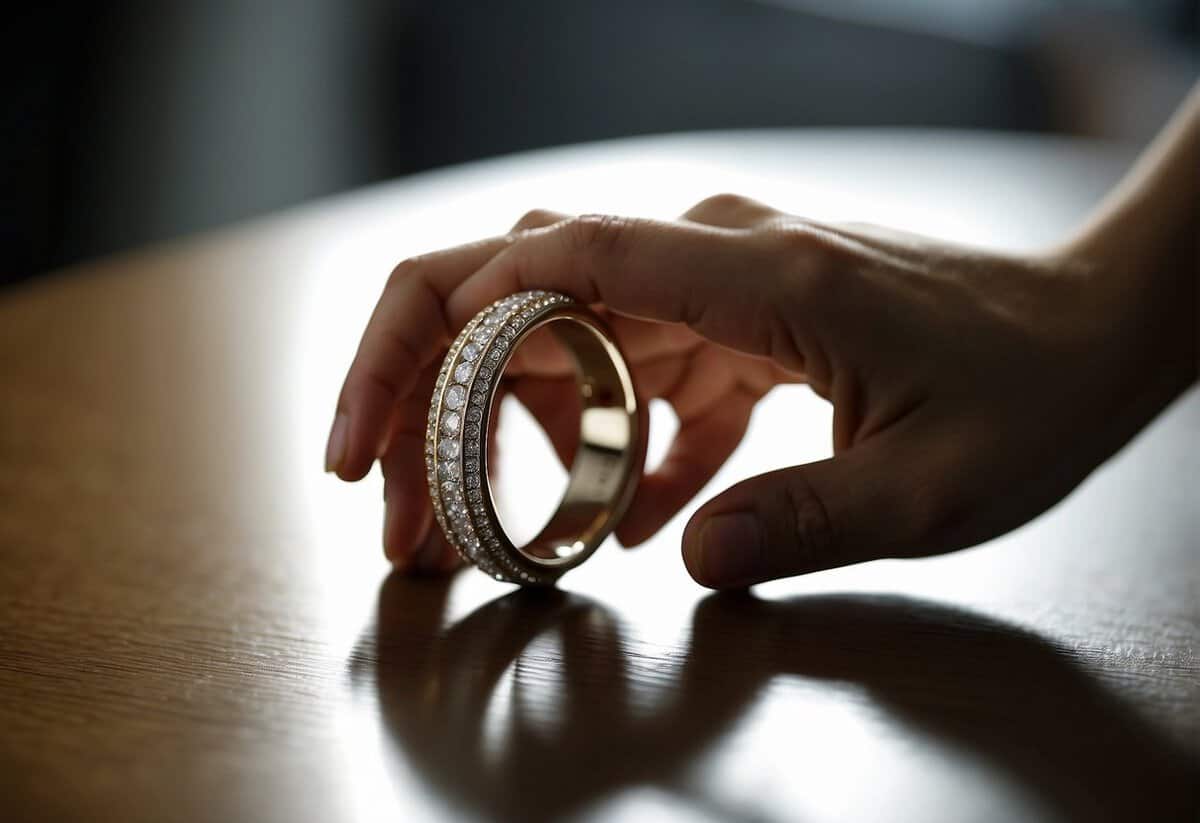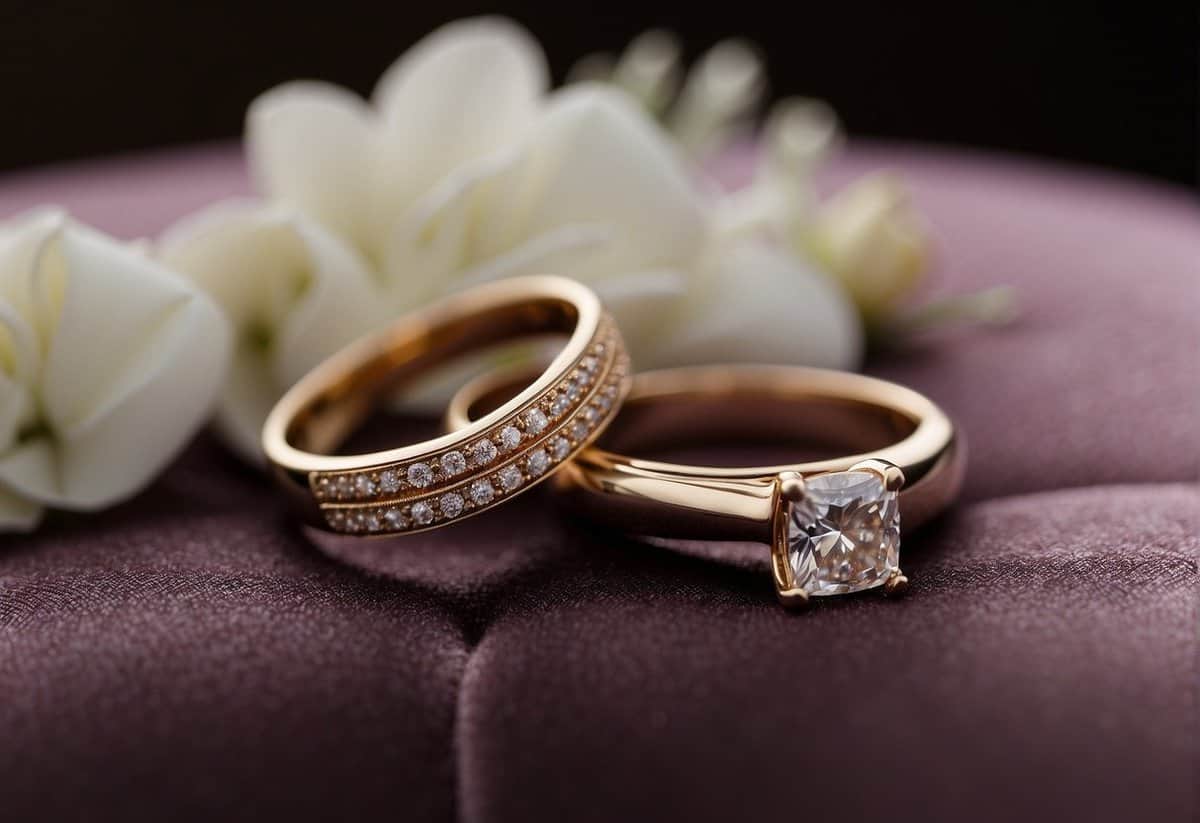Why Do You Not Wear Your Engagement Ring on Your Wedding Day? Unveiling Traditions and Practical Tips
When you picture your wedding day, you might imagine that moment when you and your partner exchange rings, a circle symbolizing eternal love and commitment. Traditionally, the wedding band, usually simpler in design, is placed on the finger during the ceremony, prompting the question of what to do with the engagement ring you’ve been wearing proudly since the proposal. The engagement ring, often a more ornate piece featuring a central gemstone like a diamond, typically takes the spotlight during the engagement period, but on the wedding day, etiquette holds a different nuance for this symbol of pre-marital commitment.

Etiquette and tradition suggest that during the wedding ceremony, the focus should be on the exchange of wedding bands. Therefore, brides often choose to switch their engagement ring to the right hand before the ceremony. This practical shift ensures that the wedding band, which many consider to have deeper symbolic meaning, is placed on the ring finger first, signifying its direct connection to the heart. After the wedding ceremony, it is common for the bride to wear her engagement ring on top of the wedding band, but ultimately, how to wear your rings is a personal choice that can reflect your style and the nature of your relationship.
Key Takeaways
- The wedding band is the focus during the ceremony and is traditionally worn closest to the heart.
- Engagement rings can be worn on the right hand during the exchange of wedding rings.
- How you wear your rings post-ceremony is a personal preference and may reflect individual style.
Traditions and Etiquette

When considering the placement of your engagement ring during your wedding ceremony, you’re engaging with centuries-old traditions and established etiquette. These customs offer a glimpse into historical significance and have evolved with modern adaptations.
Historical Significance
Traditionally, it was believed that the left hand harbors the vena amoris, or “vein of love,” which runs directly to the heart. This belief is why the ring finger on your left hand has become the historical home for both your engagement ring and, later, your wedding band. Traditional etiquette would often see the engagement ring temporarily moved to the right hand to allow the wedding band, a symbol of eternal commitment, to be placed first on the left ring finger during the ceremony.
Modern Adaptations
Today, you’ll find that traditions are more flexible, and many couples tailor the ring exchange to suit their preferences and beliefs. While some still transfer their engagement ring to the right hand before the ceremony, others choose to wear it on their left, stacked above the wedding band once it’s placed. In some cases, the engagement ring isn’t worn during the ceremony but rejoined with the wedding band afterward.
Logistics and Practicality

When preparing for your wedding day, you might be concerned about the logistics and practicality of wearing your engagement ring. Here are some specific considerations to keep in mind regarding sizing issues and ensuring the safety and security of your precious ring.
Managing Ring Sizes
Your wedding ring and engagement ring might not be the same size. On your wedding day, you’ll want to ensure that both rings fit comfortably and don’t cause inconvenience during the ceremony. If your engagement ring is a bit loose, it could slip off if worn over the wedding band. Conversely, if it’s tight, it may not fit on top of the band at all.
- Check fit: Prior to the wedding, try wearing your rings together to make sure they fit well.
- Consider adjustments: If necessary, get your engagement ring resized to comfortably sit alongside your wedding band.
Safety and Security Concerns
The last thing you want on your wedding day is to worry about the safety of your engagement ring. Traveling to and from venues and handling various activities might put your ring at risk for damage or loss.
- Safekeeping: Find a safe place or a trusted person to hold your ring during the ceremony.
- Minimizing risk: If your wedding involves travel, ensure you have a secure, designated spot for your ring to avoid misplacement.
- Plan ahead: Decide how you’ll manage these aspects well before your wedding to minimize stress on the big day.
Personal Choices

When it comes time for your wedding, personal choices play a significant role in determining whether you wear your engagement ring during the ceremony. Your decision can be influenced by your individual style and family traditions.
Aesthetic and Style Preferences
Your choice to wear your engagement ring on your wedding day may be driven by your personal preference for aesthetics. Opting for a simple look, you might choose to only wear your wedding band during the ceremony, allowing it to shine on its own. It’s a day when you want to feel comfortable and true to your own sense of style. Remember, the design of your wedding jewelry is an extension of your personality.
- With Ring: Stack your wedding band below the engagement ring post-ceremony.
- Without Ring: Give your wedding band its standalone moment during the ceremony.
Family Expectations and Decisions
Another aspect to consider is the presence of family expectations or decisions that may shape your choices. Perhaps wearing the wedding band alone honors a tradition a family member has passed down, symbolizing a fresh start or a new bond being the sole focus.
- Honoring Traditions: Wearing just the wedding band may reflect cherished family customs.
- New Trends: You may decide to set a contemporary precedent if traditional norms don’t resonate with you.
Your jewelry selections on your wedding day are an intimate aspect of how you express your union and the new journey you’re embarking on. Whether influenced by fashion-forward decisions or time-honored family practices, the choice remains uniquely yours.
Wedding Day Considerations

When preparing for your wedding day, deciding whether to wear your engagement ring may seem minor, but it has logistical and symbolic implications. Your choice affects various aspects, from the coordination with your wedding planner to the flow of ceremony activities.
Coordination with Wedding Planners
Work closely with your wedding planner to ensure there’s a plan for your engagement ring. Many brides choose to wear their engagement ring on their right hand, facilitating an easy exchange of rings during the nuptials. Others may opt to secure it in a ring box or entrust it to a reliable person. Discuss with your wedding planner where your ring should be safely kept and how it will be incorporated into the wedding ceremony or photos.
- Before the Ceremony: Confirm where your engagement ring will be.
- Right Hand: Traditional preference for many brides.
- Ring Box: A safe alternative for keeping it secure.
- After the Ceremony: Decide how it will be returned or worn.
- Necklace: Some brides temporarily wear the ring as a necklace.
- Stewardship: Assign someone you trust to hold onto the ring.
Ceremony and Reception Activities
During the ceremony, it’s crucial to consider how your engagement ring will complement the activities. If you plan to not wear your engagement ring, let your wedding planner know to avoid any confusion when exchanging vows. At the reception, if you opt to wear the ring, consider whether it might interfere with any party activities—like dancing or greeting guests—which could affect your decision.
- During the Ceremony: Decide the role of your engagement ring.
- On Finger: Ensures the ring is present without the need to transfer it.
- With Planner: A secure method handled by a professional.
- At the Reception: Think about the practicality of wearing the ring.
- Photos: Will the ring be included in wedding photos?
- Comfort: Assess if it will be comfortable throughout the event.
Frequently Asked Questions

Navigating the tradition and etiquette for engagement rings on your wedding day can be confusing. Here, the aim is to clarify common queries you might have regarding how to wear your engagement ring during your special day.
Is it considered bad luck to have your engagement ring on during the wedding ceremony?
No, it’s not considered bad luck to have your engagement ring on during the wedding ceremony. However, some people choose to wear it on their right hand to make room for the wedding band on their left.
Should the engagement ring be worn every day up until the wedding?
Yes, the engagement ring is typically worn every day up until the wedding. However, some choose not to wear it during certain activities to protect the ring from damage.
What’s the tradition for handling your engagement ring during the wedding day?
Traditionally, you wear your engagement ring on your right hand during the ceremony, so the wedding band can be placed first on the left hand ring finger. Afterwards, the engagement ring is usually moved back to the left hand.
On which finger do you wear your engagement ring after the marriage ceremony?
After the marriage ceremony, your engagement ring is traditionally worn on the fourth finger of your left hand, stacked above the wedding band.
How do you decide whether to wear your engagement ring on top or beneath your wedding band?
Deciding whether to wear your engagement ring on top or beneath your wedding band is entirely up to personal preference. Some prefer the wedding band first as it’s closer to the heart, while others like the look of the engagement ring on top.
Is it common to not wear your engagement ring to bed once you’re married?
It’s common for some to remove their engagement ring before bed after getting married. This choice is often made to prevent potential damage to the ring or for comfort reasons.


